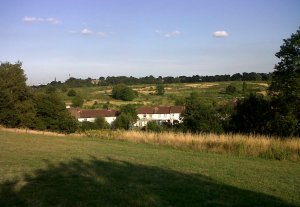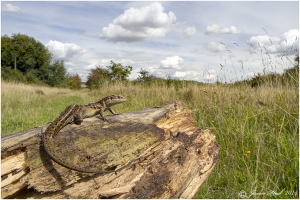Chris Rose, Vice-chair Bexley Natural Environment Forum
Erith Quarry, a Grade 1 Site of Importance for Nature Conservation, is now the subject of a planning application for 600 dwellings, which would see three quarters of its semi-natural habitat destroyed. London Wildlife Trust and Bexley Natural Forum are calling for the application as it stands to be refused and will be submitting detailed arguments, but you can help by putting in a simple objection, using some of the points set out below. Unfortunately the site is also subject to other, pro-development policies, and does not have absolute legal protection. London level policies allow some ‘development’ on SINCs ‘commensurate with their importance’, but this proportion of habitat loss is unacceptable and would set a terrible precedent. With enough objections we may be able to wring concessions, as well as helping dissuade the Council from giving too much ground to ‘developers’ ahead of final planning decisions in the future. At present it clearly doesn’t think enough people care enough about nature.
Please send your comments to: developmentcontrol@bexley.gov.uk. quoting the application code: 14/02155/OUTM
The last day for submission has now been put back to Wednesday 17th December.
There is a powerpoint with lots of information about the site and pictures of it here https://app.box.com/s/dqhdxdlv06sa0kc7zhqq , though this was written before the formal planning application was available. Although the projected number of dwellings has gone down from 700 to up to 600m, the boundary of the area proposed for ’development’ is the same.
[We apologise for the short notice. This is due to severe overload resulting from several other wildlife-hostile proposals, and the huge amount of material needing to be read concerning this application.]

The best views of Erith Quarry from outside the site are ignored in the planning application’s assessment of visual impact. Most of the area on the other side of the valley beyond the white houses would be covered in buildings. (Photo: Chris Rose)
GENERAL POINTS AND PRECEDENT-SETTING
– Recent survey evidence, though inadequate in several key respects, confirms that the site is still very important for wildlife and worthy of continuing SINC Grade 1 status. On the basis of ranking and size it is one of the 12 best wildlife sites in the Borough, and by far the best scrub site in the north of Bexley. We believe that the number of species present and their abundances will fall with this scale of ‘development’, and that species of conservation concern, including reptiles, would almost certainly be negatively affected and that some will be lost. Consequently there would be a breach of a number of important London and Bexley level policies regarding the conservation of biodiversity. The application should be refused on these grounds.
– Destroying nearly 75% of a Grade 1 SINC, sets a bad precedent and throws into question the Council’s commitment to protecting such sites, especially in the light of its proposals to sell off a quarter of open spaces (or parts of them) and its sudden 5-fold increase in projected housing builds to 2030. This degree of ‘development’ is not commensurate with the importance of the site for biodiversity. If the same extent of loss was allowed across all Grade 1, Grade 2 and Local classes of SINC in Bexley then that would be equivalent in land area to 8.3 Danson Parks or 18 East Wickham Open Spaces.
– The ‘developers’ are making much of the increase in bramble cover over recent years, which they say reduces the site’s biodiversity value, and according to them makes much of it expendable. This is a management issue and does not require a covering of concrete to sort out. If Bexley had any biological Sites of Special Scientific Interest (SSSIs) in this condition, the requirement would be to restore them, not build over a large chunk of them. If the Council accepts a ‘developer’s’ argument that a large part of a designated site should now be destroyed because of ‘unfavourable’ vegetation changes, then that will be a licence to owners of other private SINCs, who might want to sell them for ‘development’, to allow or encourage changes unfavourable to key species on them precisely in order to increase their prospects of getting planning permission.
– The developer’s own report admits that the potential of a site should be taken into account, but only the building and not the future wildlife potential is properly discussed in the voluminous planning application documents. We know that bigger sites are better for wildlife, and the new focus on ‘landscape level’ conservation and ‘habitat connectivity’ is the logical consequence of that. Leaving a margin of hemmed-in woodland and a small area of grassland in one corner contributes to the general trend of habitat fragmentation and erosion of site sizes.
– There is no analysis of the potential impact on biodiversity and thus conservation status of the neighbouring SINCs at Hollyhill or Erith Cemetery/Streamway, where numbers of species of insects and birds, and their abundances, may well be negatively affected.
– The ‘State of Nature’ (2013), ‘Living Planet’ (2014) and DEFRA ‘Biodiversity Indicators’ (December 2014) reports all show serious problems with declines in both species numbers and abundances (including of hitherto commoner species) in the UK. We submit that the appropriate and rational conclusion to draw from this is that semi-natural habitats should be protected and enhanced, not built over.
INSECTS
– Survey work for the ‘developer’ in 2014, though not conducted according to Natural England best practice in terms of the spread of months over the year, nevertheless found 47 invertebrate species of formal conservation concern, representing 12.5% of the total species inventory. The best sites for invertebrates in the wider London area are said to record 10% or greater, depending upon habitat type. We therefore we conclude that this is one of the best sites, and that the objective should be to make it better by appropriate management rather than just protecting the diminished area currently suitable for many of these species.
– REPTILES
All UK reptile species have a degree of legal protection, but unfortunately not from having their living space destroyed. On the grounds of ‘Japanese Knotweed control’, the ‘developers’ have conveniently had Slow Worms, Common Lizards and Grass Snakes, all of which are thought to be in decline nationally, and for which Bexley is a London ‘hot-spot’, moved to a small 1ha reptile-fenced ‘holding area’, within the 3.25ha area that they are claiming can support the site’s total reptile population indefinitely. It is clear from the recent aerial photography and mapping in the ‘development’ application that there is still much more suitable reptile habitat than this 3.25ha that they are ‘generously’ proposing to leave in the north west corner of the site, despite the increase in bramble. LWT and BNEF believe that reptile populations at Erith Quarry will be seriously affected by being forced into too small an area, and could be lost entirely. Numbers of animals found/caught were downplayed by the ‘developer’, but in our view are high by London and Bexley standards, and there are very few places in the Borough where all three of these species can be found, and they are large sites.

HERE BE DRAGONS! Once again Bexley Council seems to lack the backbone to stand up for our little vertebrate relatives in the face of ‘developer’ threats, and seems happy to have the important populations at Erith Quarry shoe-horned into a fraction of the currently and potentially suitable habitat. (Photo: Jason Steel – not taken at EQ!)
– The translocation that has taken place is contrary to Natural England best practice guidelines, and the paid ecologists have verbally admitted that this is the case. Approval of the ‘development’ as proposed would be the third total or significant partial destruction of a reptile site in the Borough due to Council-supported ‘development’ in the last 5 years. The last reptile translocation in the Borough was also an expedient affair that broke NE guidelines and has probably failed according to the available data.
– The London Biodiversity Partnership, consisting of Local Authorities and other organisations, has a policy aim ‘To protect and conserve the native reptile populations of Greater London.’ DEFRA says conserving species includes not just presence, but ranges and population sizes. The LBP says ‘Development and unsympathetic land management has reduced the amount of habitat available for reptiles.’
BIRDS
– LWT believes that several bird species are almost certainly going to be lost from the site as breeding birds because of the lack of suitably retained undisturbed habitat, and that this will include Whitethroat and Red-listed Linnet. Other species will also have a much reduced capacity to breed due to available space and disturbance. Vulnerable species like the Song thrush, Chiffchaff and Dunnock have the potential to become extinct on the site. A Turtle Dove was recorded on the site this year. This species is in serious danger of UK extinction, and relies on scrubby edges to woodland – which will be lost to buildings here – and good supplies of weed seeds.
BATS
– LWT is sharply critical of the quality of the Bat survey work. All Bats are strongly protected under UK law. It is proposed to have a road close up to the edge of the retained woodland, with buildings adjacent to that, contrary to the Council’s Biodiversity Action Plan policy of allowing woodland to ‘bleed out’ into scrub, and despite the emphasis in the planning application on the importance of such ‘edge’ habitat for Bats and other animal species. However well designed the lighting regime, there is likely to be leakage from buildings plus other disturbance in areas where bats might otherwise forage.
VIEWS
There is a 134 page document dealing with the effects of the development on views, complete with a number of photographs. Incredibly, this fails to include photos of the best and most open view across the valley (of the now buried Streamway stream) from Hollyhill, which provides one of the most rural-looking panoramas in the Borough. Instead it uses a sight-line in which the Quarry site is largely obscured by substantial trees.

Done. I doubt they’ll listen, but as you say, it’s worth a try to see what ‘mitigation’ we might obtain.
I’ve sent an email reiterating many of your excellent points. Let’s hope they spare a little thought for the borough’s wildlife.
yes sent objections – thanks for the prompt to the planning app. plus relevant points